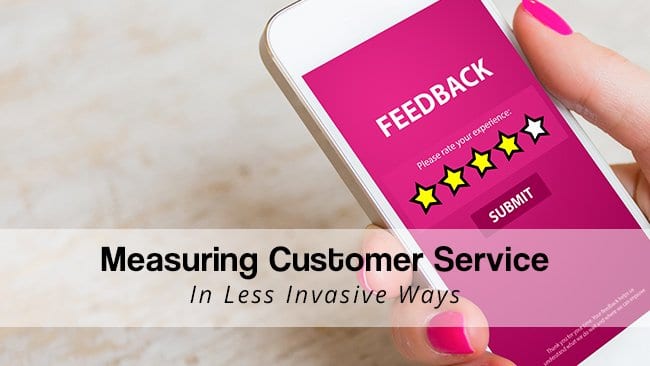
Intruder alert!
While it is crucial to find out exactly how your customer feels, in order to deliver better service, intrusive methods like surveys and callbacks can easily end up shooting your efforts in the foot.
It seems to be the standard answer from corporates today – when asked how they differentiate themselves from the competition – to state that they do so via the customer experience.
Of course, to truly differentiate yourself, you need to deliver a better experience consistently. And to achieve this, you really need to be able to appreciate the experiences customers are receiving today.
From a contact center point of view, this means being able to listen to the voice of your customer. The standard means used to understand the customers’ voice is to straight out ask them for feedback, using questionnaires, surveys and similar types of assessments. However, these methods can prove problematic, because surveys are often too long, while callbacks are often interruptive. Then there is the feeling amongst customers that companies are not going to use the information provided anyway.
The last thing you want to do is irritate your customer, as at the very least, it will mean that the information you obtain will be tainted by this irritation. At the other end of the scale, you may anger the customer to the point where it actually negatively impacts on their relationship with your organization.
And even if you use a quick and simple score or rating system to find out how the customer experience went, it won’t always provide you with a complete – or even necessarily an accurate – picture of how the individual thinks or feels about your business.
Good customer experience leaders are therefore finding and implementing other, less intrusive ways to understand the customer experience; ways that may actually prove more accurate in the long run.
If your company has its own app, you could always utilize an in-app survey, which is generally presented to the customer while they are in the process of using your service. Such an approach usually ensures an immediate reaction and delivers what is generally a higher response rate. Of course, to be used effectively, these in-app appraisals need to be inserted seamlessly into the interface. Otherwise, you will detract from the user experience and be seen by the client as pestering them. The best way is to integrate a subtle feedback bar that only has one or two questions.
It tends to be more successful and less intrusive, because the customer is asked for their opinion while they are engaged with your business. Nonetheless, when you boil it down, such an approach still relies on the concept of a survey, and as such may yet create friction between your organization and the customer.
Perhaps a better and more thorough method is to analyze the multitude of unstructured customer data available to you. This might include data from online reviews, social media posts, ‘additional comments’ in surveys, e-mails and recorded customer phone calls. It could even encompass YouTube video reviews and comments. Of course, due to the sheer quantity of the data, it can be difficult to analyze effectively.
This is where text analytics can assist you to mine the data and make sense of it. Text analytics can aid you in capturing and interpreting the voice of the customer across multiple feedback channels. Furthermore, by drawing from data gathered from a range of different channels, such analysis will help you to build useful business intelligence and uncover insights that would take any number of surveys to obtain. For example, text analytics can assist you in determining more about satisfaction levels, purchase behavior and specific product or service issues.
In effect, text analytics helps you to develop the capability to understand what customers mean, whenever they share their thoughts. A good example is that quite often, negative online reviews actually have little do to with the product purchased. Instead, they are usually focused on a range of other factors, such as your employees, pricing, business facilities, the ordering process and even the company’s environmental practices.
Successfully analyzing big data to determine exactly what the customer is thinking and feeling at the given moment puts you in a position to achieve a more complete understanding of the customer – and to do so in a far less intrusive manner than the traditional survey.
If your business is a franchise model or has offices in multiple regions, you can even structure your to capture data at the point where it’s being generated. This is achieved by assigning data to a geographic location relevant to the brand. This, in turn, means that you can not only get a better handle on those opportunities and issues that are affecting your company across all locations, you can also more accurately identify trends, themes, and issues that are specific to a single location or region.
Another valuable channel for monitoring customer happiness is social media, due mainly to its immediacy and personable touch. Social listening will enable you to obtain insights ‘from the horse’s mouth,’ with an honesty and immediacy that you would never have gotten from a staged survey. After all, customers tend to be more spontaneous and willing to talk about things when it comes to the various social media platforms. Thus, keeping track of what is said, as well as the fluctuation in followers, shares and likes on the various platforms, will give you a good idea of customers’ loyalty and overall satisfaction.
Social listening not only offers you the opportunity to tackle customer issues immediately before they flare up into a crisis but also allows you to conduct pro-active social customer service. Of course, like any other channel, social media requires investment in time, effort, and technology. Nonetheless, it is worth the investment as it offers your customer experience professionals an accurate way of determining customer feelings and attitudes, and it allows you to gain this insight without interrupting the customer to ask them to take a survey or questionnaire.
Gathering customer feedback via social media, listening and analyzing their conversations on the various platforms can help you to focus your marketing campaigns and product development far more effectively. Obviously, using social listening in isolation will not be as effective as if it is combined with other feedback mechanisms, but it can certainly reduce your need for other voice of the customer programs, including surveys.
Differentiating yourself through your customer experience is certainly an effective approach to business, and to consistently deliver the better customer experience that such differentiation requires, you need to make use of every possible means to learn more about the customer. While surveys and questionnaires will always have their place, the less intrusive your data collection methods, the more likely you are to keep your customers happy and ensure their experiences with your organization are always good.
[About the author]


